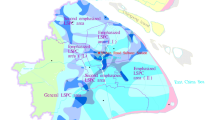Summary
The paper discusses the significance of engineering geology maps, choice of mappable units and scale, and their utility in feasibility, design, construction and post-construction stages. These aspects and the scale are governed by the nature of the superstructure, geomorphological, geological, tectonic and geoseismological setting of the area.
In India, it is incumbent to have a geological appraisal (preferably by the Geological Survey of India) before major Civil Engineering Projects are taken up. Engineering geology mapping is expected to suit the phases of planning, design and construction. The scale of engineering geology maps varies from 1∶63,360 to 1∶120. Large scale maps are prepared to project specific geological features. Base maps are primarily conventional geological maps, aerial photos and Landsat imageries. Maps for construction materials portray the utility of particular deposits and their economics. For environmental and urban geology studies, a separate method of mapping is adopted. Collection of subsurface data from underground exploration by drifts, adits etc., in the form of detailed logs and maps enable evaluation of the competence of the rock mass vis-a-vis the superincumbent structure. The existing methods present the geological, lithological and structural data with particular attention to tectonic features likely to influence Civil Engineering Works.
The paper illustrates these aspects from the case studies of major projects in Western India.
The utility of engineering geology maps meant for different aspects will in future also include adequate geomechanical data. An attempt at standardisation of engineering geology maps for different purposes would be necessary.
Résumé
L'article traite de l'importance des cartes géotechniques, du choix des unités à cartographier et de l'échelle, et de leur utilité dans les phases successives d'un projet: étude de faisabilité, préparation, construction et après-construction. Les caractéristiques et l'échelle de la carte seront déterminées par la nature de l'ouvrage et par le contexte géomorphologique, géologique, tectonique et séismologique de la région.
En Inde il est obligatoire d'avoir une expertise géologique (de préférence faite par le Service géologique de l'Inde) avant d'entreprendre la réalisation d'un important projet de travaux publics. On pense que la cartographie géotechnique est utile aux phases suivantes: avant-projet, préparation, construction. Les échelles des cartes géotechniques sont comprises entre 1/63.360 et 1/120. Les cartes à grande échelle sont préparées pour le report de particularités géologiques spécifiques. Les cartes de base sont en premier lieu des cartes géologiques classiques, des photos aériennes et des images Landsat. Les cartes des matériaux de construction représentent l'utilité de tel ou tel gisement et son économie. Pour les études de l'environnement et la géologie urbaine, une méthode de cartographie séparée est adoptée. L'exploration du sous-sol par des galeries d'accès et des travers-bancs permet de réunir des données numériques sous forme de coupes verticales détaillées et de cartes, ce qui permet d'évaluer l'aptitude de la masse rocheuse à supporter la construction projetée. Les méthodes existantes présentent les données géologiques, lithologiques et structurales, avec particulière référence aux caractères tectoniques susceptibles d'affecter les ouvrages de génie civil.
L'article èclaire ces questions en tirant profit d'études de cas de grands travaux effectués dans l'ouest de l'Inde.
L'utilité des cartes géotechniques destinées à différents usages implique qu'elles devront, à l'avenir, comprendre aussi des données géomécaniques adéquates. Il serait néccaire d'essayer de normaliser les cartes géotechniques destinées à divers usages.
Similar content being viewed by others
References
DEARMAN W.R.—FOOKES P.G. (1974): Engineering geological mapping for civil engineering practice in the United Kingdom Q.Jl. Engng. Geol., 7, 223–256.
HOUSNER G.W. (1974): Problems in seismic zoning. “Engineering seismology and earthquake engineering”, NATO Advanced Study Institute Series E, Noordhoft, Leiden.
INDIAN STANDARD INSTITUTION (1976): Criteria for earthquake resistant design of structures, 1893, Second Revision, Indian Standard Institution. New Delhi.
KASLIWAL V.K. (1971): Some geotechnical aspects of tunnelling in Erinpura Granites. Proceedings of Seminar on engineering and geological problems in tunnelling, Part II, Indian Society of Engineering Geology, Calcutta, 117–125.
MAHENDRA A.R.—MATHUR S.K. (1975): Ukai Project, Gujarat. Engineering Geology Case Histories, Geological Survey of India. Misc. Publication No. 20, 154–163.
RAJU K.C.C.—SHENOI R.S. (1973): Narmada Project, Navagam Dam Site, Gujarat. Engineering Geology Case Histories, Geological Survey of India Misc. Publication No. 20, 248–256.
SHENOI R.S. (1971): Geomechanical considerations in the treatment of river channel fault at Navagam dam site No. 3 on Narmada River, Gujarat State. Indian Society of Engineering Geology, Journal of Engineering Geology, VI, No. 1, 289–296.
SHENOI R.S.—RAMA RAO V. (1971): Leakage and liquefaction problems at Dharoi Reservoir Project, Sabarkantha District Gujarat, Seminar on Water Resources of Gujarat and Rajasthan. Geological Survey of India.
SHENOI R.S. (1975): Kadana Reservoir Project, Gujarat. Engineering Geology Case Histories, Geological Survey of India, Misc. Publication No. 20, 188–198.
SHENOI R.S. (1977): Seismotectonic features as guide to design of a high dam across Narmada River in Gujarat, India. Sixth World Conference on Earthquake Engineering. New Delhi, Preprints 2, 251.
SHERARD J.L.—CLUFF L.S.—ALLEN C.R. (1974): Potentially active faults in dam foundation. Géotechnique, XXIV, 367–426.
SRINIVASAN P.B. (1975): Koyna Hydroelectric Project I Stage, Maharashtra. Engineering Geology Case Histories, Geological Survey of India, Misc. Publication No. 20, 31–40.
UNESCO (1976): Engineering geological maps. A guide to their preparation. Earth sciences Series No. 15. The Unesco Press, Paris.
Author information
Authors and Affiliations
Rights and permissions
About this article
Cite this article
Srinivasan, P.B., Shenoi, R.S. Concepts of geotechnical mapping for river valley projects in Western India. Bulletin of the International Association of Engineering Geology 19, 226–233 (1979). https://doi.org/10.1007/BF02600479
Published:
Issue Date:
DOI: https://doi.org/10.1007/BF02600479




